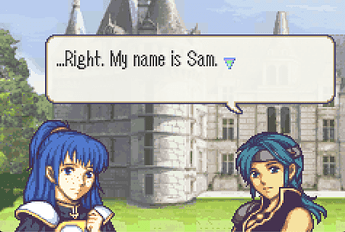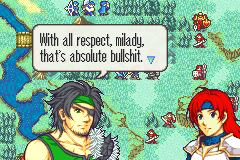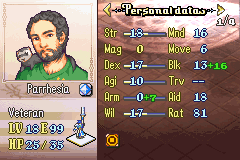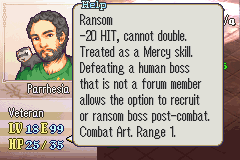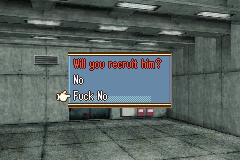Sister Thread: Effortposts Around Chapters We Like
I’m calling this a ‘collection of essays’, because that’s the sort of phrasing I need to get used to if I’m ever to get a grant from the Territory arts department.
Anyone is welcome to contribute. Actually, it’s going to be a pretty short series if it is just let up to me. I just want to write about units from custom campaigns that I really enjoy using, and I think other people should too, hopefully helping us all design novel units. This is primarily with gameplay in mind, but of course, the ludonarrative (another one of those arts grant words, you see) is part of a concern. My favourite Do5 unit is in large part because basically every boss in the late midgame knows her and battle-quotes with her. And indeed if you’re primarily talking about story, feel free, just make sure you use spoiler tags scrupulously. And, yes, by all means: make as many effortposts as you feel you have effort for. I don’t really intend to police this. The harshest I’m possibly going to be would be ‘not adding something to the table of contents’, and even then I can’t really see that happening.
Make big effort-posts. Gush. For all our sakes.
TABLE OF CONTENTS
- Esfir (Vision Quest) by Parrhesia
- Alice (Last Royal) by WaywardTroper
- Carson (Deity Device) by WaywardTroper
- Tower (Cerulean Crescent) by Taylor
- Naia (Vision Quest) by Vulgard
- Sam (TMGC) by BobbyAsaka
- Garath (Dream of Five 2012) by Pandan
- Jackson (Queen’s Sword) by SirNicee
- Stefan (TMGC) & Marlow (Cerulean Crescent) by AlexMPG
- Benji (Journeys: Gaiden) by Lowres
- Damien (TMGC) by Goldblitz
- Teodor (An Unexpected Caller) by Retina
- Ernst (OCA) & Callahan (Blessed Heart) by KrashBoomBang
- Boleslav (OCA) by JiroPaiPai
- Parrhesia (Dies Emblem) by Rivian
- Haban (Shackled Power) by Bloble
- Kelik (Last Promise) by WaywardTroper
- Sigrid (Vision Quest) by Parrhesia
- Shaun & Bradley (Four Kings) by SubwayBossEmmett
- Cromar (Bells of Byelen) by ArcherBias
- Lajos (Vision Quest) by BladerDJ
- Evelia (Absolution by ZessDynamite) by RandomWizard
- Addington (TMGC) by DrGreen
- Linda (Requiem) by KrashBoomBang
- Ava (Four Kings) by Vulgard
- Shorn (Dark Amulet) by FrisoLaxod
- Clint (Shackled Power) by Catball
- Clio (Drums of War) by Luminescent Blade
- Gecko (Cerulean Crescent) by Vulgard
- Almanac (Server 72) by Darkiway
- Samto (COT Burger) by SubwayBossEmmett
- Lex (Sun God’s Wrath) by Yasako
- Eileen (Shackled Power) by OverZealous
- Asch (The Last Promise) by Roze
- Alva (DLATMOL) by Bobby Asaka
- Tej (Tales of Cho-Hakkai) by Sigmaraven
- Malcolm (Bloodlines) by Cres
- Carmela (A Vestrian Tale) by Parrhesia
- Coventry (A Vestrian Tale) by Lowres
- ReverseCard (Dies Emblem) by HeroVP
- Janette (Liberation Blade) by CanDy
- Colm & Neimi (FE8 Reforged) by Vulgard
- Vesper! (Shackled Power) by Parrhesia
- Ellerie (Cerulean Crescent) by Madzz
- Amelia (Search for Seiso) by Fringus
- Lindros (Cerulean Crescent) by Trybel
- Melonie (Liberty’s Beacon) by DAT
- Nianyu (Spellthieves) by BandanaSplitz
- Hartmann & Victor (Dragon Herald) by HeroVP
- Tricia (Dream of Five: DE) by GigaExcalibur
- Vermillion (Cerulean Crescent) by Lumi
- Aigo (Cerulean Crescent) by Lumi
- Francis (Lords of the Seas) by AlexMPG
- Belle (Embrace of the Fog) by SSGhostShip
- Bronwyn (Homecoming) by Taylor
- Alvaro (Embers Entwined) by BobbyAsaka
- Luther (The Unbroken Thread) by SSGhostShip
- Lopez (Hag In White) by RandomWizard
- Fructuoso (Hag In White) by Parrhesia
- Kairos (Hag In White) by Luminescent Blade
- Tiresias (Hag In White) by GigaExcalibur
- Danielle (Illuminated) by Itkovian
- Krim (Dies Emblem) by GreatDoot
- Kaarlo (Eligor’s Spear) by Cornontherob
- Donovan (Sun God’s Wrath) by Vulgard
- Nicaea (Hag In White) by RNGSomeone
- Avanni (Eligor’s Spear) by DATInDemand
- Kaguya (Touhou Emblem) by TezukaYagami
- William (Lords of the Seas) by Krash
- Marzano (A Vestrian Tale) by Cygnus
- Wyler (Shackled Power) by Bpat
Esfir (Vision Quest)
The highest praise I can lavish on Esfir is that I directly made my campaign worse because of her.
I’ve never been a theft guy. I’ve never been an FE5 guy. I don’t tear my hair out if I can’t loot everything and I’ll only deploy multiple thieves begrudgingly, if the flow seems to demand it. And, like pegasus knights, my general thoughts on them are that I acknowledge their utility but I’ll only begrudgingly bring them, and probably won’t train the early one who traditionally can’t fight for shit.
For the three people reading who haven’t played Vision Quest, Esfir is a high-level thief who arrives in the earlygame as comfortably your highest-level early unit. I went to look up her stats but can’t remember where the big spreadsheet with all the stats is. Suffice to say she has roughly the stat profile you’d expect of a thief, in both bases and growths, but being overlevelled ensures she’s a strong, reliable murderer in the early stages.
So my initial thought when I saw the VQ opening party was: well, at least she’s higher-level. I’ve trained Matthew before. I’ve trained Colm. I’ve attempted to be bothered to train Lifis. It’s not my idea of a good time. This isn’t going to delve into some deep-dive of 'the Ruby Sword was masterfully calculated to get ORKOs on such and such a common enemy type, I couldn’t even be bothered to look up her stats. But as the game went on, she slowly became, in my mind, my MOTM over the course of the game.
Critically, while her stats will never be anything special - she’s probably overlevelled for the bases she has, and her growths are unremarkable - several peculiarities of VQ work in her favour. First, rogues can steal unequipped weapons. In practice, this ends up being a lot of Physic staves, but consider: that’s a lot of Physic staves. Second, the game lavishes you with statboosters. Third, the game has a fuckton of stealables, such that you’re encouraged to bring a thief on basically every map. Other thieves consist of a basically slightly worse backup Esfir in a few chapters, and a rogue a few chapters after that. Many of those stealables are, in fact, other statboosters.
Optimal Play would suggest using those statboosters on other units, and dropping Esfir for that rogue when he rocks up, but if you don’t do this - encouraged by the fact that Esfir’s a significant plot character, and a likable one at that, with a good design - it creates a pleasant feeling of a self-fuelled killing machine. Even with that, she’ll likely never be a truly strong endgame fighter. But she can keep up, and does pull her weight. Unambiguously strong at the start and with Things that she could do Best right up to the very end - and with VQ’s extremely generous late deploy caps, she stuck around even as loot ceased to matter in any meaningful way - she was the first name on the teamsheet, chapter after chapter.
How did it make my campaign worse? So flush with Esfir-love was I that immediately set about adding a bunch of Theft to DoW. This, um. This turns out to be the kind of thing you have to build the game around, not just bolt on late in the process because you liked how a certain game played. Part of it is that there still weren’t really enough to ever justify wanting to bring a thief. A statbooster is, ultimately, just the difference between a bad and a good level, and most of your units are getting a lot of both over the years. Is a single measly Talisman really worth bringing a thief to an outdoor map? And Pavel/Kalevi/Ramond all feel like taxes, in a way that Esfir, as she could still contribute well in a fight (with love), and reliably had plenty of stuff to steal, does not. Eventually, most of these changes were reverted. They work in VQ; but VQ is not DoW, and Esfir is not Pavel.
We can learn a lot, I think. First up: we’ve all experienced trying to get kills with early thieves (and pegasus knights), units we can easily find the objective utility in, and found it be like pulling teeth. Overlevelling the first examples of these classes can keep their stat profiles as expected and keep them in check long-term, while not making them complete chores to train (for another example, see Helje DoW, who I arrived at before playing VQ). Second off, context really matters. Esfir, in many hacks, would just be a glorified myrmidon.
My experience of Vision Quest at its best was like taking an empire down into a back alley and mugging it, and that’s supported by the themes of the text. Esfir is the perfect encapsulation of that feeling, and remains, to me, the gold standard of thieves across the series.
